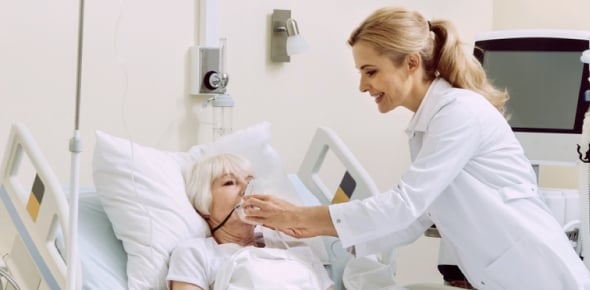A patient who is suffering respiratory distress would exhibit all of...
You are called to start a new aerosolized medication treatment. ...
You are called to the Emergency Department to help evaluate a...
A patient has acute respiratory distress syndrome (ARDS) and is...
All of the following could result in a mediastinal shift on a chest...
An annual influenza vaccination should be given to all of the...
You have finished charting on your patient when you notice that an...
After feeling a sudden chest pain and shortness of breath while...
To help you determine whether your patient has orthopnea, you would...
A frail, thin patient known to have lung cancer is admitted ot the...
Since being told of the diagnosis of cancer, a patient has become...
A 48-year-old patient with an extensive smoking history usually coughs...
The respiratory therapist has instructed a 16-year-old asthma patient...
You are called to the Emergency Department to help care for a patient...
It is most important to ask a patient with a broken ankle form a...
An adult patient with a history of smoking has shown an increased...
A batch of respiratory care equipment has gone through the gas...
After 2 days of vomiting and diarrhea caused by the flu, a 50-year-old...
A recently home-delivered baby is brought in to the Emergency...
A patient who is intubated has been moved from teh Operating Room to...
In observing an infant's chest configuration, you notice that it...
You are called to evaluate a patient's breathing pattern. ...
A tension pneumothorax is identified by which of the following?...
Your patient has distended external jugular veins, even though her...
Your patient is complaining of localized pain over the lower right...
A young adult who had surgery for a deviated nasal septum was...
You have been assisting with the insertion of a flow-directed,...
An elderly patient with congestive heart failure has been treated with...
You are called ot help in the evaluation of a 55-year old male...
You are assisting in the delivery of a high-risk neonate. At 1...
A home care company has found that several of its tracheostomy...
You are called to the Pediatrics Department to help in the evaluation...
Patients with heart or lung disease commonly have shifting of...
After use of a mechanical ventilator has been discontinued, what is...
A contaminated Bird Mark 7 intermittent positive-pressure breathing...
The radiologist remarks to you during the viewing of a 65-year-old...
A 3-day-old newborn is brought into the Emergency Department with her...
In palpating your patient for symmetrical chest movements, you notice...
An adult patient with a history of COPD and left ventricular failure...
In listening to a patient's lungs, you notice bronchial breath...
You are assisting with the delivery of a high-risk infant. After...
A respiratory therapist notices that two people in the Emergency...
A patient has been confirmed to have SARS. Which of the...
In examining your patient, you notice that she has greatly diminished...
A 65-year old patient with repeated episodes of congestive heart...
To help determine your patient's level of consciousness, you...
A hospitalized patient who recovered from a Clostridium botulinum...
What is the most cost-effective way for a respiratory care department...
A 48-year-old patient had an exacerbation of his COPD related to...
Tactile fremitus would be reduced in all of the following conditions...
A retired home care paitent living on a fixed income needs to be able...
Select all of the following that can be used in the home to reduce the...
A home care respiratory therapist is setting up a continuous home...
A 47-year-old man who recently returned from a business trip to Hong...
















